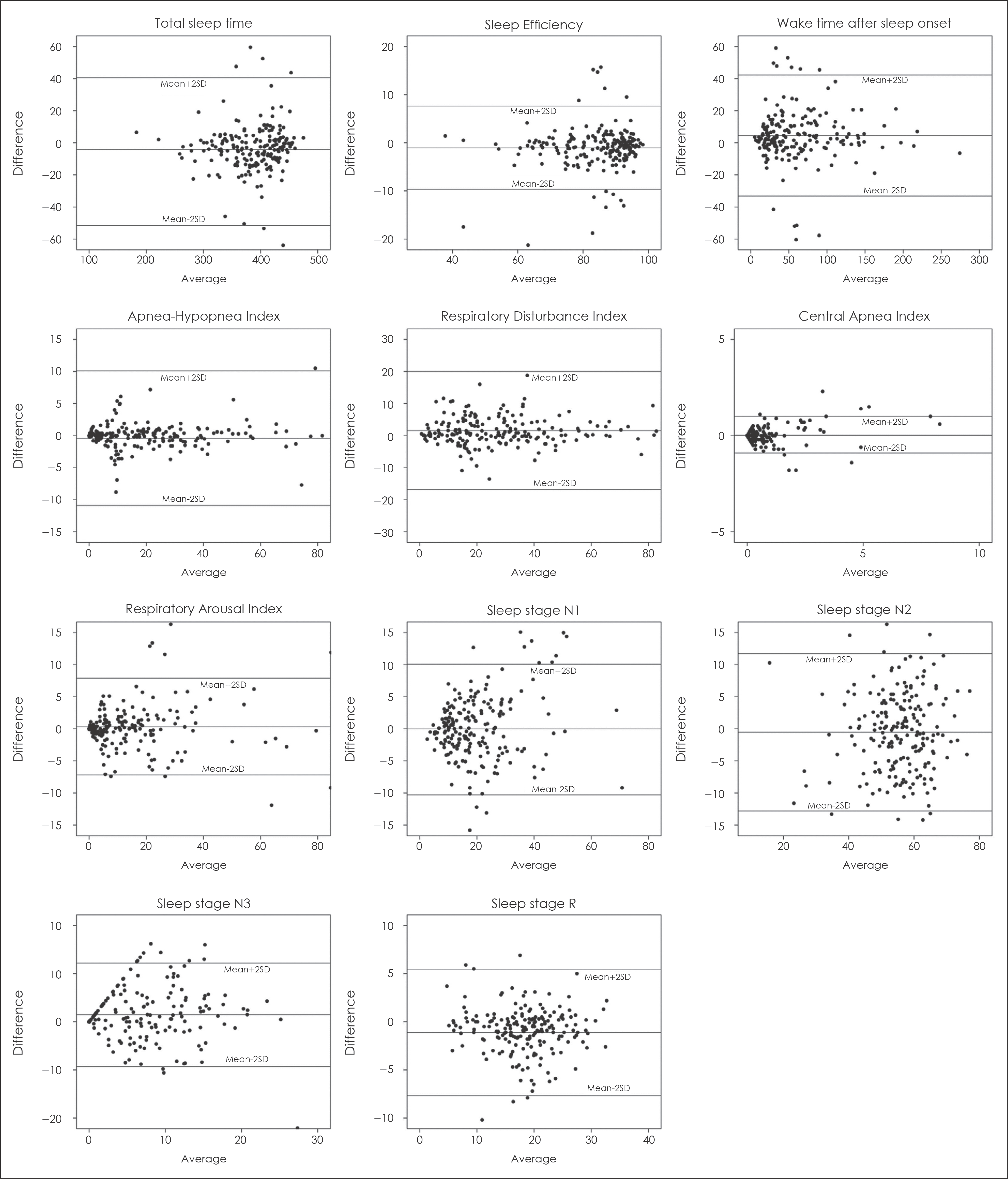Abstract
Background and Objectives:
To measure the accuracy of Embletta X100, a level 2 portable sleep monitoring device, for diagnosis of obstructive sleep apnea and assessment of sleep structure.
Materials and Method:
We enrolled 200 consecutive patients who had been referred due to habitual snoring or witnessed apnea during sleep and had undergone standard polysomnography (PSG). We created a simulated situation similar to that of the Embletta X100 using only data from PSG and scored the sleep stage and the apnea-hypopnea index (AHI). Thereafter, the results of PSG and simulated Embletta X100 were compared.
Results:
Sensitivity, specificity, and positive and negative predictive values of simulated Embletta X100 based on PSG were nearly 100% at three different cutoff values of AHI (5, 15, and 30). Intraclass correlation (ICC) of simulated Embletta X100 based on PSG was also excellent (≥0.9) for most of the sleep-related parameters and respiratory index. However, ICC of sleep stage percent was variable according to sleep stage (>0.9 for N1 and N2, 0.664 for N3, and 0.864 for R).
REFERENCES
1). Eckert DJ., Malhotra A. Pathophysiology of adult obstructive sleep apnea. Proc Am Thorac Soc. 2008. 5:144–53.

2). Aurora RN., Casey KR., Kristo D., Auerbach S., Bista SR., Chowdhuri S, et al. Practice parameters for the surgical modifications of the upper airway for obstructive sleep apnea in adults. Sleep. 2010. 33:1408–13.

3). Senaratna CV., Perret JL., Lodge CJ., Lowe AJ., Campbell BE., Matheson MC, et al. Prevalence of obstructive sleep apnea in the general population: A systematic review. Sleep Med Rev. 2017. 34:70–81.

4). Berry RB., Budhiraja R., Gottlieb DJ., Gozal D., Iber C., Kapur VK, et al. Rules for scoring respiratory events in sleep: update of the 2007 AASM Manual for the Scoring of Sleep and Associated Events. Deliberations of the Sleep Apnea Definitions Task Force of the American Academy of Sleep Medicine. J Clin Sleep Med. 2012. 8:597–619.
5). Collop NA., Anderson WM., Boehlecke B., Claman D., Goldberg R., Gottlieb DJ, et al. Clinical guidelines for the use of unattended portable monitors in the diagnosis of obstructive sleep apnea in adult patients. Portable Monitoring Task Force of the American Academy of Sleep Medicine. J Clin Sleep Med. 2007. 3:737–47.
6). Chesson AL Jr., Berry RB., Pack A. Practice parameters for the use of portable monitoring devices in the investigation of suspected obstructive sleep apnea in adults. Sleep. 2003. 26:907–13.

7). Park DY., Kim HJ., Kim CH., Kim YS., Choi JH., Hong SY, et al. Reliability and validity testing of automated scoring in obstructive sleep apnea diagnosis with the Embletta X100. Laryngoscope. 2015. 125(2):493–7.

8). Chung F., Liao P., Sun Y., Amirshahi B., Fazel H., Shapiro CM, et al. Perioperative practical experiences in using a level 2 portable polysomnography. Sleep Breath. 2011. 15(3):367–75.

9). Silber MH., Ancoli-Israel S., Bonnet MH., Chokroverty S., Grigg-Damberger MM., Hirshkowitz M, et al. The visual scoring of sleep in adults. J Clin Sleep Med. 2007. 15:121–31.

Fig. 1
Bland-Altman agreement plot for various parameters measured by standard polysomnography and simulated Embletta X100.

Table 1.
Demographics of patients
Table 2.
Sensitivities, specificities, positive predictive values, and negative predictive values of simulated Embletta X100 according to different AHI cutoff values
| Cutoff value | Embletta X100 | |||
|---|---|---|---|---|
| Sensitivity (%) | Specificity (%) | PPV (%) | NPV (%) | |
| AHI=5 | 100.0 | 98.0 | 99.3 | 100.0 |
| AHI=15 | 99.0 | 99.0 | 99.0 | 99.0 |
| AHI=30 | 100.0 | 99.3 | 98.0 | 100.0 |
Table 3.
Intraclass correlation between polysomnography and simulated Embletta X100




 PDF
PDF ePub
ePub Citation
Citation Print
Print


 XML Download
XML Download